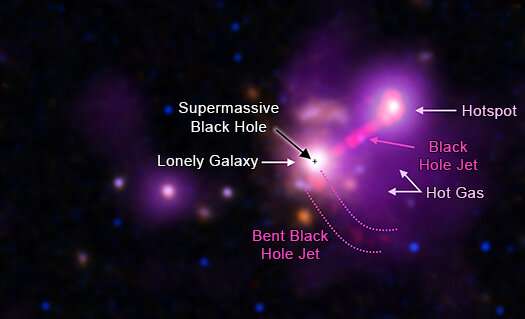Powerful yet lonely: The distant quasar left alone in its group

Looking at the night sky with the naked eye, we can only see an infinitesimal part of what the Universe contains, and the largest part cannot even be “seen”. Radio wavelengths have gifted us some of the most fascinating astronomical sources: radio-loud active galactic nuclei in the centers of galaxies, which can produce jets that extend way farther out from the optical galaxy itself.
The most powerful radio sources in the northern hemisphere are listed in a well- studied catalog, the Third Cambridge Catalog (3C), which contains the source we investigated with multiwavelength observations: 3C 297. This source appeared very intriguing in observations performed with Chandra in 2016. Therefore, we requested more time to better investigate features that we uncovered thanks to this first short observation, such as hot, X-ray emitting gas around our source.
This source is very far from us and, therefore, very far in the past. Optical, radio and X-ray observations were crucial to draw the full picture of such a powerful, and old, astronomical source. At the beginning of this journey, we wanted to investigate if this source was hosted in a galaxy cluster, that is, the ensemble of 100 galaxies or more. At that time in the universe’s evolution, galaxy clusters are still forming and X-ray observations can be used not only to identify a galaxy cluster through the glow of the hot gas they contain, but also to verify if mergers with other clusters are occurring or not.
Moreover, powerful radio sources tell us where to look for galaxy clusters at large distances from Earth. But there comes the contradiction: the detection of hot gas with Chandra pointed toward the presence of a galaxy cluster, i.e. we expected that about a 100 or more galaxies should be around 3C 297. Optical data revealed, instead, no galaxies.
We therefore think that we have observed a so-called “fossil group”, that is, a system with an amount of X-rays that is typical for a galaxy group. Galaxy groups are ensembles of tens of galaxies (not hundreds as it is for galaxy clusters), that are called “fossil” when we observe only a single isolated giant elliptical galaxy without companions. The companions have, indeed, merged to form one entity in the early universe. This is the first time a fossil group has been observed at such a high distance from us.
Apart from all the exciting science we performed, this work is also a wonderful international collaboration, and shows the value of perseverance and hard work. In fact, we had just completed our preparation for optical observations with the Gemini telescope to test whether the giant elliptical galaxy had companions when the pandemic hit and the telescopes closed. The first program lapsed without science data, and the second proposal submission was unsuccessful. We then applied (a third time) to the fast turnaround program at Gemini North and finally obtained science data! In the meantime, Chandra observations were delivered in over two years.
Citation:
Powerful yet lonely: The distant quasar left alone in its group (2023, March 8)
retrieved 8 March 2023
from https://phys.org/news/2023-03-powerful-lonely-distant-quasar-left.html
This document is subject to copyright. Apart from any fair dealing for the purpose of private study or research, no
part may be reproduced without the written permission. The content is provided for information purposes only.
For all the latest Science News Click Here
For the latest news and updates, follow us on Google News.

